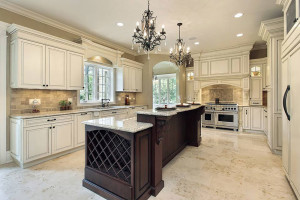 When you think of the most glamorous and pleasing aspects of your home, floors may not be the first thing that comes to mind. But when it comes down to it, the floors in your home are one of the most important elements. Equally vital in terms of both form and function, quality floors hold the design of a room together and provide vital functionality for decades.
When you think of the most glamorous and pleasing aspects of your home, floors may not be the first thing that comes to mind. But when it comes down to it, the floors in your home are one of the most important elements. Equally vital in terms of both form and function, quality floors hold the design of a room together and provide vital functionality for decades.
Choosing a material for your floors isn’t always the easiest process, either. With so many styles and materials available, you might have trouble deciding on the best way to satisfy both your tastes and your budget.
The most common options are carpet, vinyl, wood and tile. There are also more exotic materials, such as natural bamboo, granite, or other types of stone. If you have the budget and the taste for more exotic flooring, one of these options might suit you; but chances are, you’ll end up choosing between carpet, wood, tile and vinyl.
So how can you go about this decision strategically and methodically? How can you be sure you’ll love your choice? There’s no way to be 100% certain until you see the actual floors installed—but if you break the choices down according to a few key categories, you’ll have a great chance of ending up with the floors you really want.
The Look and Feel of Your Floors
Wood: Few people will deny that natural wood floors are some of the most appealing out there. When a quality material is expertly installed in a room that is conducive to the feel of wood floors, the results can be truly stunning. They also feel great underfoot (albeit a little cold during winter months).
Carpet: A popular choice for any room, carpet floors are soft and comfortable and can make your home feel more inviting. They can feel hot in the summer, and some stains can stick around permanently.
Vinyl: This type of flooring is usually not regarded as the most aesthetically appealing choice, but it does stay cool underfoot and a tasteful design can look good.
Tile: Once regarded as a weak flooring option in terms of appearance, tile is now hugely popular in homes of all types, including some of the most upscale homes out there. The surface stays cool when the weather gets hot, although not as warm as carpet in colder months.
Overall Lifespan and Maintenance Requirements
Wood: In terms of lifespan, good quality wood can age well and easily last 10 years with proper maintenance. It doesn’t have the longevity of tile, however, and you have to be careful when cleaning. Wood is highly susceptible to damage and discoloration.
Carpet: In order to keep your carpet in the best possible shape, you’ll need regular professional cleanings. Maintenance can also be an issue if there are burns or stains on the carpet. In terms of longevity, ten years is a fair bet for quality carpets that have been taken care of.
Vinyl: Cleaning vinyl floors is typically easy, as the surface is highly resistant to water. If you want a low maintenance floor, vinyl is something to consider; however, it typically has a much shorter lifespan because the material is simply not as durable.
Tile: In most cases, tile is the longest lasting and lowest maintenance type of flooring on the market. Like vinyl, tile is largely impervious to stains and water damage. No professional cleanings should be necessary as long as the floors are kept clean through ordinary cleaning methods.
Budget and Pricing Considerations
Wood: Prices for natural hardwood can top $30 or more, depending on the type of material you choose. There are cheaper natural hardwoods, but a high quality wood flooring will definitely not be your cheapest option.
Carpet: You’ll find a very broad range of prices when shopping for carpet. When you get down to the price of tile or vinyl ($5 or less per square foot), you probably won’t be looking at very good carpet. $11 per square foot is a more realistic price to pay for high quality carpet.
Vinyl: If you’re looking for the absolute cheapest option out there, vinyl could be your material. You can get away with paying a dollar per square foot or even less in some cases; but these materials are often as cheap as they sound.
Tile: Due to the wide range of styles and materials used to make tile, prices range widely. You might pay as low as $3 per square foot or as high as $20 for specialty tiles. Very good quality tiles in a plethora of styles are commonly available in the $5 per square foot range, making it one of the most affordable options. Note: Some tile installation companies will give discounts if you purchase the materials and installation at once.
Making the Right Call
There are many considerations when choosing a material for your floor—not the least of which is your personal taste and budget concerns. By breaking your decision down and approaching it in the most practical way possible, you’ll have a better chance of being happy with your decision in the long run.
Good luck designing your new floors, and thanks for reading! Feel free to comment below.
